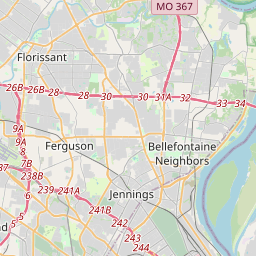Lewis and Clark
Historical marker location:
12810 Columbia Bottom Road, Spanish Lake, Missouri
( Marker is on Upper Columbia Bottom Road, in the median.)







© OpenStreetMap contributors
Confluence. Columbia Bottom, Missouri
A brief timeline of the Lewis and Clark Expedition
- 1803: President Thomas Jefferson commissions Meriwether Lewis, his personal secretary, to lead an expedition to explore the western territories of the United States and find a practical route to the Pacific Ocean.
- 1804: Lewis meets up with William Clark, a former army officer and experienced explorer, in Kentucky. They assemble a team of over 30 men and set out on the journey up the Missouri River.
- 1805: The expedition reaches the Rocky Mountains and crosses the Continental Divide. They build Fort Clatsop on the Pacific coast and spend the winter there, before returning east in the spring of 1806.
- 1806: Lewis and Clark split up to explore different routes on their way back to St. Louis. They reunite in September and return to civilization, where they are celebrated as national heroes.
- 1807: The Lewis and Clark Expedition publishes an official account of their journey, called the "History of the Expedition Under the Command of Captains Lewis and Clark," which becomes a bestseller and helps to promote westward expansion.
More history nearby
The "Show-Me State" is Missouri's official nickname and is believed to have originated from a speech given by Congressman Willard Duncan Vandiver in 1899. He said, "I come from a state that raises corn and cotton and cockleburs and Democrats, and frothy eloquence neither convinces nor satisfies me. I am from Missouri. You have got to show me."
About St. Louis County
St. Louis County Timeline
St. Louis County, Missouri has a rich history that spans back to its earliest indigenous inhabitants. Native American tribes, including the Mississippian culture, were the first known settlers in the area. The arrival of French explorers in the late 17th century introduced European contact and the establishment of fur trading posts. However, it was the Louisiana Purchase in 1803 that marked a significant turning point in the history of the region, as St. Louis County became part of the growing United States.
Throughout the 19th century, St. Louis County experienced rapid growth and development. The area became a key trade and transportation hub due to its strategic location along the Mississippi River. The construction of the Erie Canal and later the railroad network further facilitated trade and led to increased industrialization. In the mid-1800s, St. Louis County witnessed an influx of immigrants, particularly from Germany and Ireland, who contributed to the cultural diversity and economic prosperity of the region.
During the 20th century, St. Louis County continued to evolve. The county experienced suburbanization and population growth, as many residents moved out of the city of St. Louis to seek a quieter suburban lifestyle. This trend was accompanied by the development of new residential communities, shopping centers, and infrastructure. However, this increased suburbanization also led to racial segregation and socioeconomic disparities.
In recent years, St. Louis County has faced various social and economic challenges. The county has been a focal point for civil rights movements and protests against racial injustice, highlighted by the events that unfolded in Ferguson in 2014. Efforts have been made to address these issues and promote inclusivity and equality. St. Louis County remains an important economic and cultural center in the Midwest, and its history continues to shape its present and future.
Throughout the 19th century, St. Louis County experienced rapid growth and development. The area became a key trade and transportation hub due to its strategic location along the Mississippi River. The construction of the Erie Canal and later the railroad network further facilitated trade and led to increased industrialization. In the mid-1800s, St. Louis County witnessed an influx of immigrants, particularly from Germany and Ireland, who contributed to the cultural diversity and economic prosperity of the region.
During the 20th century, St. Louis County continued to evolve. The county experienced suburbanization and population growth, as many residents moved out of the city of St. Louis to seek a quieter suburban lifestyle. This trend was accompanied by the development of new residential communities, shopping centers, and infrastructure. However, this increased suburbanization also led to racial segregation and socioeconomic disparities.
In recent years, St. Louis County has faced various social and economic challenges. The county has been a focal point for civil rights movements and protests against racial injustice, highlighted by the events that unfolded in Ferguson in 2014. Efforts have been made to address these issues and promote inclusivity and equality. St. Louis County remains an important economic and cultural center in the Midwest, and its history continues to shape its present and future.
St. Louis County Timeline
This timeline provides a glimpse into the major events and milestones that have shaped the history of St. Louis County, Missouri.
- 1764 - St. Louis County is established by the French, becoming part of the Louisiana Territory.
- 1804 - The area is acquired by the United States as part of the Louisiana Purchase.
- 1812 - St. Louis County is organized as a county within the Missouri Territory.
- 1822 - St. Louis County becomes part of the newly established state of Missouri.
- 1876 - The city of St. Louis secedes from the county, forming an independent city.
- 1950s-1960s - Suburbanization begins in St. Louis County, leading to rapid population growth.
- 2014 - Protests erupt in response to the police shooting of Michael Brown in Ferguson, a suburb of St. Louis County.